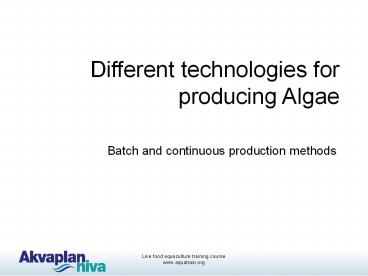Live food aquaculture training course - PowerPoint PPT Presentation
Title:
Live food aquaculture training course
Description:
Different technologies for producing Algae Batch and continuous production methods Main culture systems Batch culture 300 or 500 litre sacs D-ended tanks Continuous ... – PowerPoint PPT presentation
Number of Views:128
Avg rating:3.0/5.0
Title: Live food aquaculture training course
1
Different technologies for producing Algae
- Batch and continuous production methods
2
Main culture systems
- Batch culture
- 300 or 500 litre sacs
- D-ended tanks
- Continuous culture
- Connected sac system (SeaSalter)
- Tubular fence (BioFence)
- Tubular spiral (AddaVita)
- heterotrophic production (Aqua Fauna)
3
Batch Culture
- Indoors Greenhouse
4
Tank culture
- Advantages - large volumes
- Disadvantages - weak culture, prone to
contamination - Small tanks large tanks
5
SeaSalter SystemContinuous Algal Production,
Systems, SeaCAPS
- Adapted batch culture technique
- Plastic Sacs connected together
- dosing pump water and nutrient supply
- overflow into common collector
6
SeaSalter SeaCAPSwater supply
7
SeaSalter SeaCAPSalgae collection
8
SeaSalter SeaCAPS
- Equipment required
9
SeaSalter SeaCAPS
- Water pasteurised before distribution
- Nutrients and carbon dioxide are metered in
continuously - All pipework is designed to be steam sterilised
weekly - They can be installed
- indoors,
- in greenhouses (with or without supplementary
lighting - outdoors under shade
10
SeaSalter SeaCAPS
- Each 500 litre bag will yield 80-120 litres of
algae per day. - The expected production of a 40-bag unit would be
4-5 cubic metres per day of quality algae. - Cell density is dependent on light availability
and required flow rates - draws less than 3kW of power excluding lights
11
SeaSalter SeaCAPS
- Requires about 2 man-days per week are enough to
run a 40-bag installation and take care of stock
and starter cultures - 500 Litre polythene bags are run for an average
of four months and discarded before collapsing - A typical greenhouse-type installation with
artificial illumination can attain a cell density
of 4000 cells/microlitre.
12
SeaSalter SeaCAPS
MaxMar Mariscos, Laguna Manuela in Baja
California with a 12 bag layflat system to
support their hatchery to grow C. gigas and
scallops.
13
SeaSalter SeaCAPS
- lay flat bag systems outdoors which operate with
no artificial light.
14
SeaSalter SeaCAPS
- Norway
- Scalpro AS produce scallops and oysters at Rong,
near Bergen. Their upright system built into an
old fish processing plant has been working since
1996
15
Tubular reactors
- BioFence
- Addavita
- Why do we change from batch to continuous high
density production?
16
Theory
- In a tank or algal bag system, the zone of
penetration is low. Once the cells move away from
that surface then light cannot penetrate and
photosynthesis ceases. However, this dark area
allows more complex protein building to occur
within the algae. Due to sacs diameter the ratio
of light to dark area is small and so algal
growth is limited.
17
Transparent tubes, self-cleaning
- Very tough, very clear food grade plastic tubes.
- They are self cleaning thanks to patented special
cleaning beads that continuously circulate with
the algae. This enables the system to be run for
extended periods without culture crashes or
cleaning.
18
Space saving and reliable
- Space saving - The tubes can be mounted
vertically in a fence like arrangement or
horizontally on the ground or at an angle on a
roof. They take up a lot less room than other
growing methods and of course, they are growing
far more concentrated algae so even less space is
required. - Reliable -Can operate for long periods before
crashing, consistent quality of product. - Efficient - save on labour costs
19
Ready prepared nutrients
There are two major sources of error in growing
algae preparation and contamination ready made
nutrients with complete formulation in sterile,
concentrated liquid form
20
BioFence
- Clear pipe fence reactor
21
BioFence
22
BioFence Production
23
BioFence Production
24
BioFence Greenhouse
25
BioFence indoors
26
AddaVita
- Clear pipe spiral reactor
27
(No Transcript)
28
AddaVita reactor
29
AddaVita outdoors and indoors
30
AddaVita controls
31
Heterotrophic production
32
Boa photobioreactor
33
Prism photobioreactor
34
Tubular photobioreactor
Schematic Diagram of Tubular Photobioreactor
Height 1.5m
Diameter 30 cm
35
Tubular photobioreactor































